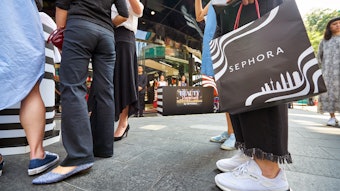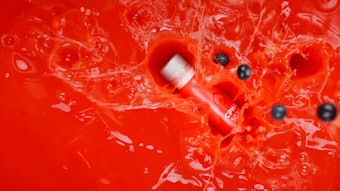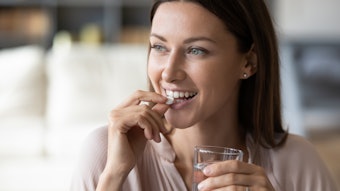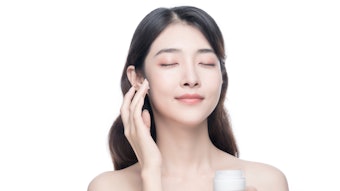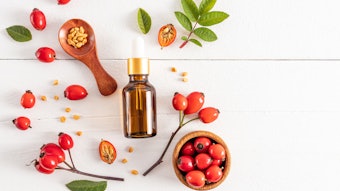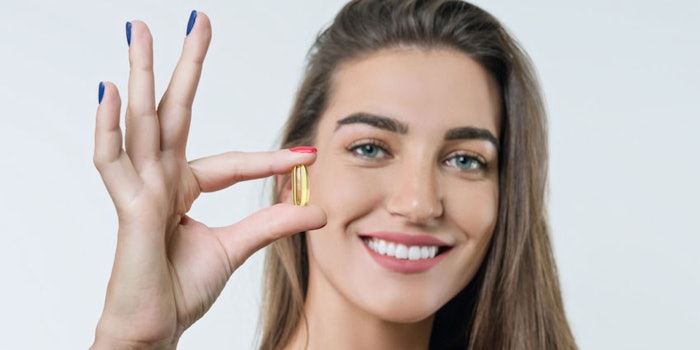
Concerns over the damaging effects of sun exposure to skin continue to grow as increasing evidence becomes available. In relation, the market for sun protection has extended beyond topical sunscreens, and growing scientific research supports sun protection from within as an adjunct approach to topical sunscreens.
UV radiation is a major extrinsic factor affecting the skin. It induces several harmful responses, including erythema, immunosuppression, edema, sunburn, hyperplasia, hyperpigmentation, premature aging and skin cancer. UVA (320-400 nm) and UVB (280-320 nm) are the wavelengths of greatest concern, and while UVA accounts for more than 90% of total UV radiation, UVB photons are one thousand times more capable of causing sunburn than UVA.1
UVA is also thought to play a crucial role in photoaging. It has been shown to cause epidermal hyperplasia, stratum corneum thickening and the synthesis of inflammatory cytokines and metalloproteinases (MMPs).2, 3 Meanwhile, UVB causes sunburn, sun tanning, pigmented spots and wrinkles, and accelerates skin aging. As a result, finding ways to protect skin cells against both UVA and UVB damage can provide long-term skin health benefits.
As is well-known, skin photoprotection is traditionally achieved via topical sunscreens. However, for various reasons, topical sunscreens alone can fail to provide reliable all-day defense for the skin. For one, most consumers apply sunscreen at just one-quarter of the advised application rate of 2 mg/cm2,4 which would mean a product designed to offer an SPF of 50 would only deliver one quarter of this protection.5
Even if a topical product is applied in sufficient quantity, it can wear off as a result of everyday activities such as sweating or rubbing against clothing. Furthermore, most people only apply topical sunscreens when they are actively seeking sun exposure but UV radiation is ubiquitous, and it is an exposure we cannot entirely avoid. It is estimated that 80% of an individual’s lifetime sun exposure occurs incidentally.6
Therefore, in addition to topical sunscreen, supplemental strategies might be considered. In this context, a growing number of studies supports the beneficial effects of oral photoprotection taken as dietary supplements. Indeed, several vitamins, minerals, carotenoids and polyphenols from botanical sources have been proven effective to help prevent sunburn and skin damage, and contribute to life-long protection against the damaging effects of UV radiation.7, 8
See related: Voodoo Lily, Hydrangea, MSM and More, Nutricosmetics in the Literature
Rosemary and Grapefruit Efficacy In vitro
Rosemary polyphenols including rosmarinic acid, carnosic acid and carnosol have previously been shown to reduce the damaging effects of UV radiation and ionizing radiation.9-13 Studies also have indicated that naringin, a citrus bioflavonoid, is capable of protecting cells against both UVA and UVB damage.14, 15 Taken together, the protective effects of citrus and rosemary extracts on UV-induced damage were assessed by the author’s company in human HaCaT keratinocytes and in human volunteers (described later) after oral intake.16
Cell viability: Briefly, the survival of HaCaT cells was assessed via an MTT assay after UVB radiation (800 or 1200 J/m2 dose) in the presence of individual or combinations of extracts at a 1:1 ratio, in a concentration range of 12.5-100 µg/mL. The researchers hypothesized the dissimilar polyphenolic compositions of citrus and rosemary could provide complementary protective mechanisms by reaching different cellular targets.
The combination showed a higher level of protection at all concentrations, compared with individual citrus or rosemary extracts. For example, when cells were exposed to 1,200 J/m2, the combination achieved 60% protection at 100 µg/mL, whereas individual citrus and rosemary extracts at 50 µg/mL achieved cell protection levels of 13% and 5%, respectively (data not shown).16
Antioxidant effects: The study also demonstrated, via a comet assay and decreased chromosomal aberrations in X-irradiated human lymphocytes, that the combined extracts decreased UVB-induced intracellular reactive oxygen species (ROS) and prevented DNA damage in HaCaT cells (data not shown). Researchers therefore concluded that rosemary and grapefruit extracts contain phenolic compounds that work synergistically to systematically scavenge free radicals generated by solar radiation.16
Rosemary and Grapefruit Supplements In vivo
MED: Preclinical and in vivo studies were carried out next to examine the effects of a combined rosemary and grapefruit extract supplementa for sun protection benefits. The human intervention assay was carried out in 10 healthy human subjects after oral ingestion and by calculating the subjects’ MEDs at different timepoints.
The daily oral consumption of 250 mg showed significantly increased MEDs after eight weeks (34%, data not shown). MEDs were higher after 12 weeks of consumption (56%, data not shown), indicating that longer oral treatments could improve UV protection effects.16
Redness and photoaging: In another independent study, the supplementa was assessed for effects on individual susceptibilities to UVR exposure—i.e., redness and lipoperoxides, and improvements in skin wrinkles and elasticity.17 For this clinical study, the 95 subjects were divided into three groups and supplemented with 100 mg or 250 mg of the test supplement, or a placebo. The researchers then exposed volunteers’ backs to UV light and measured levels of skin damage at regular intervals.
Rosemary and grapefruit extracts contain phenolic compounds that work synergistically to systematically scavenge free radicals generated by solar radiation.
Treated subjects showed a decrease in both UVB- and UVA-induced skin alterations, and after 8 weeks, their MEDs increased by approximately 30%, confirming earlier study results.16 Results also indicated the supplement provided healthy aging benefits, reducing wrinkle depth by 15% and improving skin elasticity by 9% (data not shown).17 Furthermore, no significant differences were noted between the 100 mg and 250 mg supplement doses, and positive effects were observed beginning at 2 weeks of product consumption.
Discussion
The overall results suggest the long-term oral intake of the described supplementa could serve as a complementary strategy to prevent the negative effects of sun exposure. In vitro tests also postulate these protective effects occur through the inhibition of UVR-induced reactive oxygen species and, potentially, their concomitant inflammatory markers together with their direct action on intracellular signaling pathways. The clinical trials performed demonstrate healthy aging benefits, such as a gradual increase in individual sun tolerance, as demonstrated by MED, and ROS scavenging to help skin recover from sun overexposure.
Conclusion
Consumers globally are turning to functional ingredients to deliver a wide range of healthy aging benefits including skin care, sun protection and beauty from within. In relation, the grapefruit and rosemary supplementa described herein shows sun protection efficacy while nicely aligning with the broader trend for beauty from within. A growing number of studies supports the beneficial effects of oral photoprotection, suggesting it is now possible to extend topical sun protection using supplements.
a Nutroxsun is a product of Monteloeder
References
1. Svobodova, J., Psotova, D., and Walterova (2003). Natural phenolics in the prevention of UV-induced skin damage. Available at: https://pubmed.ncbi.nlm.nih.gov/15037894/
2. Lavker, R.M., Gerberick, G.F., Veres, D., Irwin, C.J. and Kaidbey, K.H. (1995). Cumulative effects from repeated exposures to suberythemal doses of UVB and UVA in human skin. J Amer Acad Dermatol 32 53-62.
3. Wlaschek, M., Heinen, G., Poswig, A., Schwarz, A., Krieg, T. and Scharffetter-Kochanek, K. (1994). UVA-induced autocrine stimulation of fibroblast-derived collagenase/MMP-1 by interrelated loops of interleukin-1 and interleukin-6. Photochem Photobiol 59 550-556.
4. Kim, S.M., Oh, B.H., Lee, Y.W., et al. (2010) The relation between the amount of sunscreen applied and the sun protection factor in Asian skin. J Am Acad Dermatol 62 218-222.
5. Faurschou, A. and Wulf, H.C. (2007) The relation between sun protection factor and amount of sunscreen applied in vivo. Br J Dermatol 156(4) 716-719.
6. Teens Health from Nemours (accessed 2020, Oct 14). Tanning. Available at: https://kidshealth.org/en/teens/tanning.html
7. Pérez-Sánchez, A., Barrajón-Catalán, E., Herranz-López, M. and Micol, V. (2018). Nutraceuticals for skin care: A comprehensive review of human clinical studies. Nutrients 10(4) 403.
8. Parrado, C., Philips, N., Gilaberte, Y., Juarranz, A. and González, S. (2018, Jun 26). Oral photoprotection: Effective agents and potential candidates. Front Med (Lausanne) 5 188.
9. Vostálová, J., Zdarilová, A. and Svobodová, A. (2010). Prunella vulgaris extract and rosmarinic acid prevent UVB-induced DNA damage and oxidative stress in HACAT keratinocytes. Arch Dermatol Res 302 171-181.
10. Psotova, J., Svobodova, A., Kolarova, H. and Walterova, D. (2006). Photoprotective properties of Prunella vulgaris and rosmarinic acid on human keratinocytes. J Photochem Photobiol B 84 167-174.
11. Sanchez-Campillo, M., Gabaldon, J.A., Castillo, J. ... Lozano, J.A., et al. (2009). Rosmarinic acid, a photoprotective agent against UV and other ionizing radiations. Food Chem Toxicol 47 386-392.
12. Del Bano, M.J., Castillo, J., Benavente-Garcia, O., Lorente, J., Martin-Gil, R., Acevedo, C. and Alcaraz, M. (2006). Radioprotective-antimutagenic effects of rosemary phenolics against chromosomal damage induced in human lymphocytes by gamma-rays. J Agric Food Chem 54 2064-2068.
13. Alcaraz, M., Acevedo, C., Castillo, J., Benavente-Garcia, O., Armero, D., Vicente, V., and Canteras, M. (2009). Liposoluble antioxidants provide an effective radioprotective barrier. Br J Radiol 82 605-609.
14. Greinert, R., Volkmer, B., Henning S., et al. (2012). UVA-induced DNA double-strand breaks result from the repair of clustered oxidative DNA damages. Nucleic Acids Res 40(20) 10263‐10273.
15. Ren, X., Shi, Y., Zhao, D., et al. (2016). Naringin protects ultraviolet B-induced skin damage by regulating p38 MAPK signal pathway. J Dermatol Sci 82(2) 106‐114; doi: 10.1016/j.jdermsci.2015.12.008
16. Perez-Sanches, A., et al. (2014, Apr). Protective effects of citrus and rosemary extracts on UV-induced damage in skin cell model and human volunteers. J Photochem and Photobiol B: Biology; doi: 10.1016/j.jphotobiol.2014.04.007
17. Nobile, V., et al. (2016). Skin photoprotective and anti-aging effects of a combination of rosemary (Rosmarinus officinalis) and grapefruit (Citrus paradisii) polyphenols. Food & Nutr Res 60 31871; available at: https://www.ncbi.nlm.nih.gov/pmc/articles/PMC4931025/

